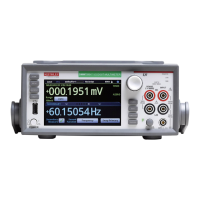el DMM7510 7½ Digit Graphical Sampling Multimeter Reference Manual Section 2:
DMM7510-901-01 Rev. B / May 2015 2-111
Offset-compensated ohms
The voltage offsets caused by the presence of thermoelectric EMFs (V
EMF
) can adversely affect
resistance measurement accuracy. To overcome these offset voltages, you can use offset-
compensated ohms.
For 4-wire resistance measurements, when offset compensation is enabled, the measure range is
limited to a maximum of 100 kΩ. Offset compensation is automatically enabled when dry circuit is
enabled.
For 2-wire resistance measurements, offset compensation is always set to off.
For temperature measurements, offset compensation is only available when the transducer type is
set to 3-wire or 4-wire RTD.
See Offset-compensated ohm calculations (on page 4-14
) for additional detail on calculating
offset-compensated ohms.
Dry circuit ohms
Standard resistance measurements have open-circuit voltage levels from 6.4 V to 14.7 V, depending
on the selected range. Dry circuit ohms limits open-circuit voltage to between 20 mV and 27 mV. This
allows you to perform resistance measurements that require low open-circuit voltage, such as power
and low-glitch resistance measurements.
You can use dry circuit ohms for ranges up to 10 kΩ (maximum resistance of 2.4 kΩ) for the four-wire
resistance function.
You can use offset-compensated ohms used with dry circuit ohms to cancel the effect of
thermoelectric EMFs. When dry circuit is enabled, offset compensation is automatically set to on.
Measuring contact resistance (oxide film build-up)
The ideal resistance between switch connectors or relay contacts is 0 Ω. However, an oxide film may
be present on the switch or relay contacts. This oxide film could add resistance on the order of
several hundred milliohms. Also, this oxide film changes the contact resistance over time and with
changes in the environmental conditions (such as temperature and humidity).
Typically, the four-wire ohm function of the Model DMM7510 or a standard DMM is used to measure
low resistance. However, if standard resistance measurements are performed, the relatively high
open-circuit voltage may puncture the oxide film, and render the test meaningless.
Dry circuit ohms limit voltage to 25 mV to minimize any physical and electrical changes in a measured
contact junction. This low open-circuit voltage will not puncture the film, and will therefore provide a
resistance measurement that includes the resistance of the oxide film.
Oxide films may also build up in connections on a semiconductor wafer. To accurately measure the
resistance introduced by the oxide film, dry circuit ohms should be used to prevent oxide film
puncture.

